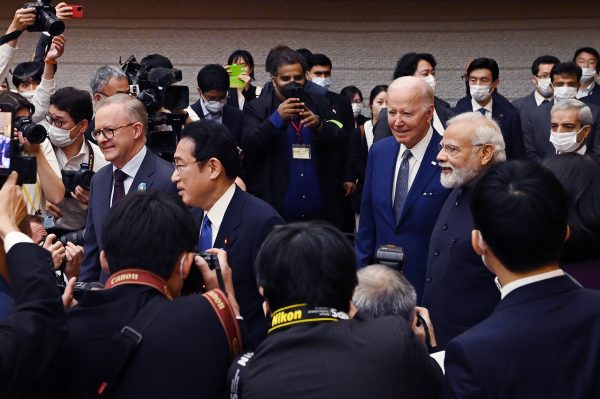Japan is pursuing a two-pronged strategy. On one hand, it has pushed back against China’s threats to territorial sovereignty. On the other hand, Japan has continuously engaged with China diplomatically and economically to shape its behaviour by using international rules and norms. The FOIP is the core of this diplomatic strategy. Its fundamental objective is to defend and enhance the existing rules-based international order.
To date, Japan’s FOIP vision has been remarkably successful. Japan conducted ‘tactical hedging’, using ambiguous diplomacy to incorporate reactions from regional states and shape the FOIP concept over time. As current international legitimacy rests on multilateralism, this diplomatic strategy has enabled Japan to nurture international coalitions that can push back against rising challengers, particularly China.
Introduced in 2016 by Japan, the FOIP concept drew the attention of the United States and contributed to the evolution of the US Indo-Pacific strategy. Simultaneously, Japan enhanced strategic ties with the United States, Australia and India, forging the institutionalisation of the Quad. Emphasising the importance of ASEAN unity and centrality, Japan attempted to alleviate ASEAN’s concerns over its potential diplomatic marginalisation by major regional powers.
Japan has also engaged and helped to shape China’s behaviour. One of the core components of Japan’s FOIP is to promote quality infrastructure in the Indo-Pacific. It originates from Japan’s 2015 Partnership for Quality Infrastructure and emphasises openness, transparency, economic efficiency and debt sustainability. Despite initial reluctance, China accepted these principles by agreeing to the G20 Principles for Quality Infrastructure Investment established at the 2019 Osaka summit. Cooperation with China also benefited from bilateral summits in 2018 and 2019.
This positive strategic trend has been disrupted since 2020. The COVID-19 pandemic imposed a diplomatic hiatus that indefinitely postponed the Japan–China summit scheduled for April 2020. Meanwhile, China’s assertiveness in the East and South China Seas continued to worry Japan, and its political and social suppression — including human rights violations in Xinjiang, restrictions on political freedom in Hong Kong and diplomatic and military coercion towards Taiwan — drew international attention. China’s less than critical diplomatic stance towards Russia’s invasion of Ukraine has shown Japan that China’s perspective on international rules and norms is incompatible with its FOIP principles.
Japan increasingly sees China as the most serious challenge to the existing international order. But tactical hedging is struggling to shape China’s behaviour in a sufficiently agile manner. Japan’s perception of China is also being influenced by the shifting strategic posture of like-minded states. The United States, the United Kingdom, France, Germany, Italy and other EU member states have raised serious concerns about China and are seeking security and economic cooperation with regional states to push back against China’s assertiveness.
This trend points towards a closer alignment of Japan with the United States and its partners, such as Australia and India, to further strengthen diplomatic pressure and military deterrence against China. These relationships risk the formation of divisions throughout the Indo-Pacific region. Yet, if Japan is not proactive, the existing international order will be eroded, as will the ability to realise Japan’s FOIP vision.
Striking a policy balance is a significant challenge, but with limited strategic options, Japan needs to make a choice soon. Japan must understand the degree of strategic commitment that like-minded states have towards the Indo-Pacific region. Many states and international organisations continue to express strong interest in increasing their diplomatic, economic and military engagement in the region. This is welcomed as their presence would enhance the region’s situational awareness, particularly in maritime security. However, as the Russia–Ukraine war indicates, regional contingencies reduce the strategic attention and commitment of external actors.
Fundamental values, such as human rights, the rule of law and democracy are increasingly important in shaping the Indo-Pacific order. Japan has been reluctant to criticise violation of these because it strictly adheres to a non-interference principle. This passive diplomatic posture makes it easy for Japan to promote its FOIP vision to non-democratic states. But there are visible, grave violations of those values — in Hong Kong, Xinjiang and Myanmar — that cannot be dismissed. If Japan stays reticent, its diplomatic posture would contradict its FOIP principles.
The roles of emerging minilateral and multilateral frameworks in the Indo-Pacific must be identified. While ASEAN has been the centre of East Asian regional multilateralism, the emergence of the Quad, the Australia–United Kingdom–United States partnership and the Indo-Pacific Economic Framework complicates the future of regional institutional arrangements. Although the members of these new frameworks express respect for ASEAN centrality, this is seen as diplomatic rhetoric. Without identifying their specific roles, new institutions will lose ASEAN’s confidence and could face diplomatic opposition from some ASEAN member states.
There is no silver bullet to resolve these challenges. China may exploit them as a part of its ‘divide and conquer’ strategy. Japan must engage with like-minded states and ASEAN to clarify the strategic and institutional division of labour and to proactively protect fundamental values in non-democratic states.
Nearing the inflection point of the FOIP, Prime Minister Fumio Kishida’s administration has promised a ‘FOIP plan for peace’ by Spring 2023. This continues the legacy of the founding father of the FOIP, former prime minister Shinzo Abe. But the strategic environment is changing rapidly and is very different from 2016. It is Kishida’s responsibility to address emerging challenges so that Japan remains a pivotal player and contributor to peace and prosperity in the Indo-Pacific.
Kei Koga is Assistant Professor at the School of Social Sciences, Nanyang Technological University, Singapore.
This article appears in the most recent edition of East Asia Forum Quarterly, ‘Japan’s strategic choices’, Vol 14, No 3.

